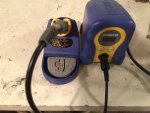- Joined
- Jul 4, 2008
- Messages
- 2,499
- Points
- 113
Hey, I am not new to soldering but I wanted to start a soldering thread, possibly to discuss new techniques, new low temp solders, heat shrinking etc...
I just got a new Hakko digital soldering station for Xmas. I gave it a go today and I was impressed with the preset temps. p1-p5 are selectable and modifiable.
My electronic solder PbSn (Eutectic Solder) 63:37 alloy melts at around 360F /182c and is best flowing at 400-410F (204c-210c). I get the best joins in this range.
Fooling around with the temps, my soldering iron is able to do Pb free as well, not that I intend to as it is far beyond being safe for electronic circuits.
Anyone else have soldering info they'd like to share on the thread?
I took an actual soldering class last year and love it.
I ended up being top in the class including doing an SMC reflow project above and beyond
the course curriculum. Anyways I've always wanted a professional setup to work on stuff at home.
My wish came true today. I really want to get into building more lasers and other things.
Today while waiting for Christmas lunch, I repaired an MMC made from 0.68uF 1600VDC CDE Pulse discharge caps.
* The intention is to get our 7.5KW SGTC back up and running with a RSPG. (we'll try a vacuum gap with a blower with NSTs) but go with our 14.4Kv PT, on a Variac
turned down to 12Kv.
The total tank cap is ~123nF @ 35.2Kvdc (~16,000Vac).
I just got a new Hakko digital soldering station for Xmas. I gave it a go today and I was impressed with the preset temps. p1-p5 are selectable and modifiable.
My electronic solder PbSn (Eutectic Solder) 63:37 alloy melts at around 360F /182c and is best flowing at 400-410F (204c-210c). I get the best joins in this range.
Fooling around with the temps, my soldering iron is able to do Pb free as well, not that I intend to as it is far beyond being safe for electronic circuits.
Anyone else have soldering info they'd like to share on the thread?
I took an actual soldering class last year and love it.
I ended up being top in the class including doing an SMC reflow project above and beyond
the course curriculum. Anyways I've always wanted a professional setup to work on stuff at home.
My wish came true today. I really want to get into building more lasers and other things.
Today while waiting for Christmas lunch, I repaired an MMC made from 0.68uF 1600VDC CDE Pulse discharge caps.
* The intention is to get our 7.5KW SGTC back up and running with a RSPG. (we'll try a vacuum gap with a blower with NSTs) but go with our 14.4Kv PT, on a Variac
turned down to 12Kv.
The total tank cap is ~123nF @ 35.2Kvdc (~16,000Vac).
Attachments
Last edited:






